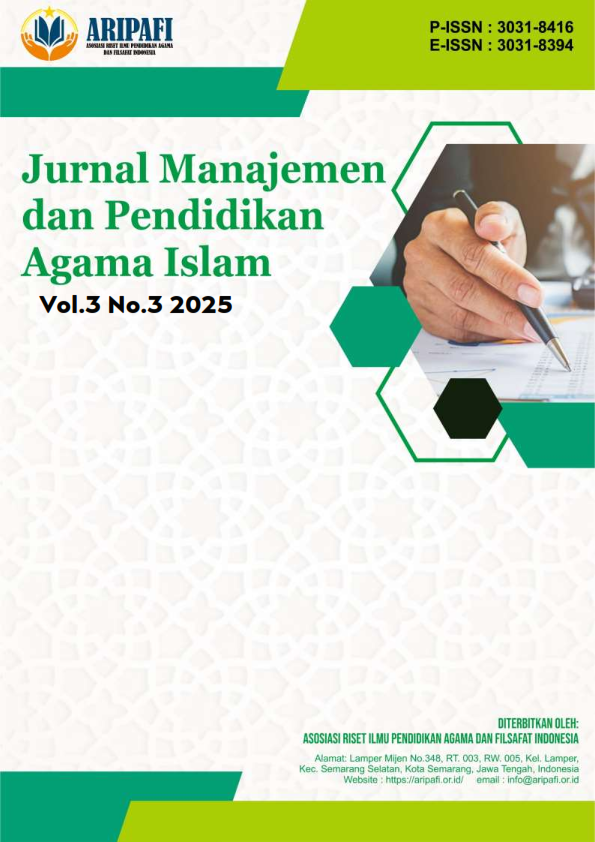Analisis Pembelajaran Al-Qur’an Hadits di Man 2 Karawang: Studi tentang Metode, Fasilitas, dan Faktor Pendukung Penghambat
DOI:
https://doi.org/10.61132/jmpai.v3i4.1197Keywords:
Hadith Learning, Independent Curriculum, Market Place Activity, Snowball Throwing, Role Play, Educational Facilities, MAN 2 KarawangAbstract
This research was conducted at MAN 2 Karawang, focusing on the analysis of Al-Qur'an and Hadith learning, particularly regarding methods, facilities, as well as supporting and inhibiting factors. The location was chosen based on the school's commitment to developing flagship programs such as the Tahfidz Al-Qur'an (Qur'an memorization) and Rohis (Islamic Spiritual) mentoring, alongside the challenges faced in optimizing the memorization of Juz 30 and students' understanding of Arabic script. The research method used a descriptive qualitative approach with data collection techniques through observation, interviews, and documentation. The results showed that innovative methods such as Market Place Activity, Snowball Throwing, and Role Play proved effective in increasing student participation and comprehension. Facilities such as a large TV for Tahsin (Qur'an recitation improvement) and a Rohis room also served as key supporting factors. However, obstacles such as extreme weather and power outages occasionally disrupted the learning process. In conclusion, a combination of creative methods, adequate facilities, and teacher adaptability played a crucial role in the success of Al-Qur'an and Hadith learning at MAN 2 Karawang, although infrastructure improvements are needed to address technical challenges.
Downloads
References
Ainley, M. (2011). Interest and Enjoyment. Dalam R. Pekrun & L. Linnenbrink-Garcia (Eds.), International Handbook of Emotions in Education (hlm. 205-227). Routledge.
Arikunto, S. (1990). Prosedur Penelitian: Suatu Pendekatan Praktik. Rineka Cipta.
Arikunto, S. (2008). Manajemen Penelitian. Rineka Cipta.
Asy-Syatibi. (2006). Al-Muwafaqat fi Ushul al-Syari’ah. Dar al-Kutub al-Ilmiyah.
Direktorat KSKK Madrasah. (2020). Panduan Pembelajaran Al-Qur’an Hadits Madrasah Aliyah. Kementerian Agama RI.
Fredricks, J. A., Blumenfeld, P. C., & Paris, A. H. (2004). School Engagement: Potential of the Concept, State of the Evidence. Review of Educational Research, 74(1), 59-109.
Gearlach, V. S., & Ely, D. P. (1971). Teaching and Media: A Systematic Approach. Prentice-Hall.
Hamdani. (2011). Strategi Belajar Mengajar. Pustaka Setia.
Heinich, R., Molenda, M., & Russell, J. D. (1986). Instructional Media and the New Technologies of Instruction. John Wiley & Sons.
Kementerian Agama RI. (2019). Standar Isi Pendidikan Agama Islam dan Bahasa Arab di Madrasah. Kementerian Agama RI.
Lin, C. H., Zhang, Y., & Zheng, B. (2016). The Roles of Learning Strategies and Motivation in Online Language Learning: A Structural Equation Modeling Analysis. Computers & Education, 113, 75-85.
Linnenbrink-Garcia, L., Rogat, T. K., & Koskey, K. L. (2012). Affect and Engagement During Small Group Instruction. Contemporary Educational Psychology, 37(3), 186-197.
Miles, M. B., & Huberman, A. M. (1994). Qualitative Data Analysis: An Expanded Sourcebook. Sage Publications.
Pupuh Fathurrohman & M. Sobry Sutikno. (2007). Strategi Belajar Mengajar. Refika Aditama.
Rossi, P. H., & Breidle, W. (1966). Evaluation Research: A Systematic Approach. Sage Publications.
Ruhyana. (2016). Model Pembelajaran Market Place Activity. Jurnal Pendidikan Islam, 5(2), 45-60.
Ryan, R. M., & Deci, E. L. (2000). Self-Determination Theory and the Facilitation of Intrinsic Motivation, Social Development, and Well-Being. American Psychologist, 55(1), 68-78.
Sanjaya, W. (2012). Strategi Pembelajaran Berorientasi Standar Proses Pendidikan. Kencana.
Schiefele, U. (1991). Interest, Learning, and Motivation. Educational Psychologist, 26(3-4), 299-323.
Silberman, M. L. (2006). Active Learning: 101 Strategies to Teach Any Subject. Allyn & Bacon.
Sopiatin, P. (2010). Manajemen Belajar Berbasis Kecerdasan Spiritual. Alfabeta.
Subagiyo, A. (2013). Teater dan Pendidikan Karakter. Pustaka Pelajar.
Sudirman. (1987). Psikologi Pendidikan. Remaja Rosdakarya.
Suparman, A. (1997). Desain Instruksional. PAU-PPAI Universitas Terbuka.
Wahyuningrum, E. (2004). Faktor Penghambat Pembelajaran. Jurnal Pendidikan, 12(1), 23-35.
Zubaedi. (2011). Desain Pendidikan Karakter. Kencana.
Downloads
Published
How to Cite
Issue
Section
License
Copyright (c) 2025 Jurnal Manajemen dan Pendidikan Agama Islam

This work is licensed under a Creative Commons Attribution-ShareAlike 4.0 International License.





